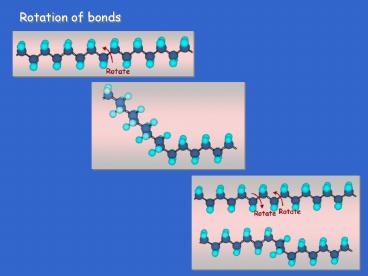Rotation of bonds PowerPoint PPT Presentation
Title: Rotation of bonds
1
Rotation of bonds
2
Viscous flow
Occurs only by shear
3
Viscous flow
Most polymer melts are shear-thinning
(pseudoplastic) - i.e., become thinner at high
shear rates
4
Viscous flow
Viscosity increases with MW Plot is for zero
shear rate values
5
(No Transcript)
6
Creep of cellulose acetate
7
Relaxation in PMMA
8
Creep recovery
9
Some specific polymers
Very rigid and strong, Tg 60-80 C siding,
pipe, conduit, usw.
Presence of Cl gives rise to solubility in
various organic solvents - allows "solvent
welding"
10
Some specific polymers
Presence of Cl gives rise to solubility in
various organic solvents Rigid PVC difficult to
form by some techniques (e.g., calendaring)so
add solvent as "plasticizer"
PVC sheet then roll-formed onto fabric backing
and - voilá - "vinyl"!
11
Some specific polymers
Rigid PVC difficult to form by some techniques
(e.g., calendaring)so add solvent as
"plasticizer"
PVC sheet then roll-formed onto fabric backing
and - voilá - "vinyl"!
Problem solvent slowly evaporates, esp. when
(auto) vinyl seats fascia heated by sun
Armorall to the rescue! Periodically put solvent
back into polymer
12
Some specific polymers
silicones
Oils - Low MWliquids lubricants, hydraulic
fluids, water repellants, usw.
Elastomers - intermediate MW, crosslinked waterp
roofing, caulk, prostheses, usw.
Molding compds - high MW, crosslinked non-struct
ural parts, insulation, usw.
Crosslinking moisture reacts w/parts of chain
to crosslinkacetic acid is byproduct of rxn
13
Some specific polymers
-O-C-O- -C- -n
H
O
H-C-H
H-C-H
H
polycarbonate
Non-crystalline, nearly as strong as highly
crystalline nylon, but tougher (stiff chain,
pendant groups, H bonding betwn chains)
High TM form at elevated temps
14
Some specific polymers
Nylon cousin, but far stronger (very stiff chain)
Non-burning, very high TM, solvent resistant
When made into fibers gt Kevlar
15
Some specific polymers
PowerShow.com is a leading presentation sharing website. It has millions of presentations already uploaded and available with 1,000s more being uploaded by its users every day. Whatever your area of interest, here you’ll be able to find and view presentations you’ll love and possibly download. And, best of all, it is completely free and easy to use.
You might even have a presentation you’d like to share with others. If so, just upload it to PowerShow.com. We’ll convert it to an HTML5 slideshow that includes all the media types you’ve already added: audio, video, music, pictures, animations and transition effects. Then you can share it with your target audience as well as PowerShow.com’s millions of monthly visitors. And, again, it’s all free.
About the Developers
PowerShow.com is brought to you by CrystalGraphics, the award-winning developer and market-leading publisher of rich-media enhancement products for presentations. Our product offerings include millions of PowerPoint templates, diagrams, animated 3D characters and more.

